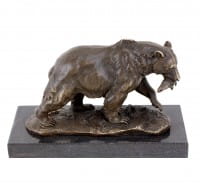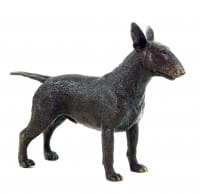Animal depictions are very popular
This is a trend that has continued throughout all of the history of art. Painters such as Edouart Manet or Charles Hunt included the animal motif in their paintings. There are numerous poems about animals in literature. Worth mentioning are "The Frogs", a poem by Johann Wolfgang von Goethe, and "Peaceful Moment" by Gottfried Keller. Apart from several sculptures and statuary art, the animal motif was a prominent theme of Viennese erotic nudes. Other popular forms of animal sculptures are bronze dogs, especially bulldog statues, and horse sculptures. They are pretty, decorative elements in any room and can uniquely show one's appreciation for the creatures of nature.
Animal depictions in the arts
Animals have been a part of human life from the very beginning. Starting as sources of food, they have developed into partners of humans. We are fascinated by the world of animals. This fascination obviously also could be found in the works of artists. Animal depictions are significantly older than those of humans, and to this day, we have formed a kind of neighbourly bond with animals which is characterised by ups and downs, and which can be difficult and complicated and afflicted with contradictions and projections. Like no other field, the fine arts have dealt with the depiction of animals and their complex relationship to humans. Even today, animal depictions are very popular. Often, animals are reduced to a single characteristic in order to transform them into a symbol. Therefore, the most common depictions are those of lion, tiger, deer, bull and horse sculptures. Quite often, this symbolic power is also used in the field of literature.
Animals as initiators of art
Since the beginning of time, humans have engaged themselves with animals. The earliest depictions are coined by a relationship between humans and animals that was about the fight for survival. This very primordial relationship between humans and animals was recorded in cave paintings. Little figurines and sculptures of animals also stem from the Stone Age. Before the advent of religion, the biggest question for humans was how to survive from one day to the next. This was recorded in their paintings. Animals drove those early artists to transform animalistic powers and instincts into spiritual and artistic power.
The emergence of animals in works of art
On the walls of those caves and in the form of little figurines, the animal was at first depicted as what it was: an animalistic being. Later on, its appearance became a symbol for power, intelligence or even malice. Symbolically, it even stood for the appearance of a god in numerous depictions. The animal in the way of a painting or a sculpture was heavily symbolically charged. After artists departed from religious themes, they focused on more worldly themes. Even though the symbolic power of the animal was retained, it retreated into the background. In paintings or sculptures, an individual being now rather represented its whole species. For example, the depiction of a horse only rarely showed a specific horse. It was more of a representation of its kind, it represented the idea of a horse as a stand-in for the whole species. To this day, the archetype of an animal is a popular motif in paintings and figurines.
Two ways of animal depictions
As a painting or sculpture, the creature is shown in its subconscious, rash and animalistic existence. From this, two ways of depicting an animal were created. On the one hand, it was wholly an animal and stood for its species, on the other hand, it received a high amount of symbolic power. Man projected the specific characteristics of animals onto himself. If we talk about aggressiveness, malice, cowardliness, softness or loyalty, we automatically connect a fitting animal to each of those characteristics. The arts coined those impressions more than the actual behaviour of the animals. A donkey, for example, is only rarely stubborn, but it is described as such anyway, and a fox is also not really cunning in real life. In reality, animals as parts of paintings and sculptures provide information about humans and their animalistic behaviour. Depictions that aim at the purely bodily characteristics are often closer to the truth. Energy and power are unarguable traits of a bull. Every depiction of a bull, be it a painting or a sculpture, shows unrestrained power. Yet both variations try to depict the character of humans.
The skilful positioning of animal sculptures
You have found an animal sculpture that shows what you want to express? Now you only need the right place for the figurine. Small sculptures work best if you individually put them on a shelf. Just below eye level, this position allows the best view on the art work. Make sure that the sculpture has enough room to have an effect. A place on a lower shelf limits the view on the figurine or might stifle it visually. The same applies if the room that is reserved for the sculpture is too narrow. Furthermore, you should not divert the attention away from the art work. If there are books or other figures that are too close to your piece of art, it might get lost in the overall picture and not be able to fully develop its impact. A fitting background that presents a nice contrast to the sculpture perfects the scenery. A fitting light can be another highlight. However, you should make sure that the light is not too bright. Atmospheric reflections can be pleasant, but if the light is too bright, the details of the sculpture might disappear in it. Animal sculptures are also popular garden decorations. In this case, you should ensure a free spot. Large sculptures can be put on the ground, but smaller sculptures may get lost in the garden. Therefore, you should give them a heightened place on a column. The figures have the best effect if they get a heightened place in the middle of a patch.
The artists of our animal sculptures
At our online shop we offer various bronze animal sculptures, bronze dogs, bulldog statues or horse statues for sale. Among other things, you will find products in our assortment that are replicas of great works of famous artists. Every product is adorned with a signature that refers to the original artist. In our shop you can find works by Antoine-Louis Barye and Rembrandt Bugatti. Both artists created incomparable bronze animal sculptures.
The French sculptor Antoine-Louis Barye
Antoine-Louise Barye lived in Paris from 1795 until 1875. During this time, he achieved the reputation of a marvellous animal sculptor. At the age of 14, he began to learn the profession of a metal engraver. However, he was enlisted for the army. In the engineer corps, he learned how to draw and mould plans of forts. After his dismissal, he studied artistic moulding with the help of sculptor Francois Joseph Bosio. Soon, he achieved his first successes and won a price for his relief "Milo of Kroton During the Fight With a Lion". However, the exhibition of his other works were not as successful. Therefore, Barye decided not to exhibit his works anymore. He started working for a goldsmith and intensively occupied himself with animal studies. In 1831, he once again presented a work of his, "Tiger Tearing a Crocodile Apart", to the public. From this moment on, he was known as a great animal sculptor. For his sculpture "Lion Ripping a Snake", he even was knighted for the Legion of Honour. The Duke of Orléans was one of his best customers. After some initial difficulties, Barye achieved great successes with his works. He never left Paris, the city of arts, but this did not hinder his success. A work by Barye should not be missing from any collection of animal sculptures. Look for his works in our shop.
Extraordinary animal figurines - Rembrandt Bugatti
Rembrandt Bugatti is the brother of the famous designer of cars, Ettore Bugatti. However, in the field of statuary art, Rembrandt is just as well-known. From 1884 until 1916, he lived in Italy, Belgium and France. Already during his youth, he showed an aptitude for sculptures. The enrolment in an academy of art was not necessary for him. At the age of 16, he made his debut with a sculpture at the spring exhibition of 1901 in Milan. From the very beginning, he was so fascinated by animals that they would continue to be a motif of his works his whole life. His first animal sculptures were mostly cows. But visits of several zoological gardens inspired him to depict more exotic animals. Bugatti was the first who made tapirs, marabous and kangaroos the motifs of European statuary art. The energy and elegance of wild cats fascinated him immensely. His animal sculptures of wild cats are therefore especially impressive. The young artist garnered a lot of praise, respect and success. Exhibitions in Milan, Turin or Venice created a big stir. In the form of bronze castings, his works found their way into numerous important collections. His brother Ettore used the standing elephant as the radiator mascot of the famous Bugatti Type 41 Royale. However, the success could not prevent Rembrandt from being affected by the impressions of the First World War. He developed health problems and depressions. At the age of 31, he took his own life in Paris. He left behind amazing animal sculptures that would complete any collection. Browse through our online shop to find his works!
Do you have any questions? Please contact us!
We gladly answer all your questions about the dog and horse statues for sale, our shipping terms or our approach to data protection. Just contact us via email or phone and we will gladly process your request.






























